Share
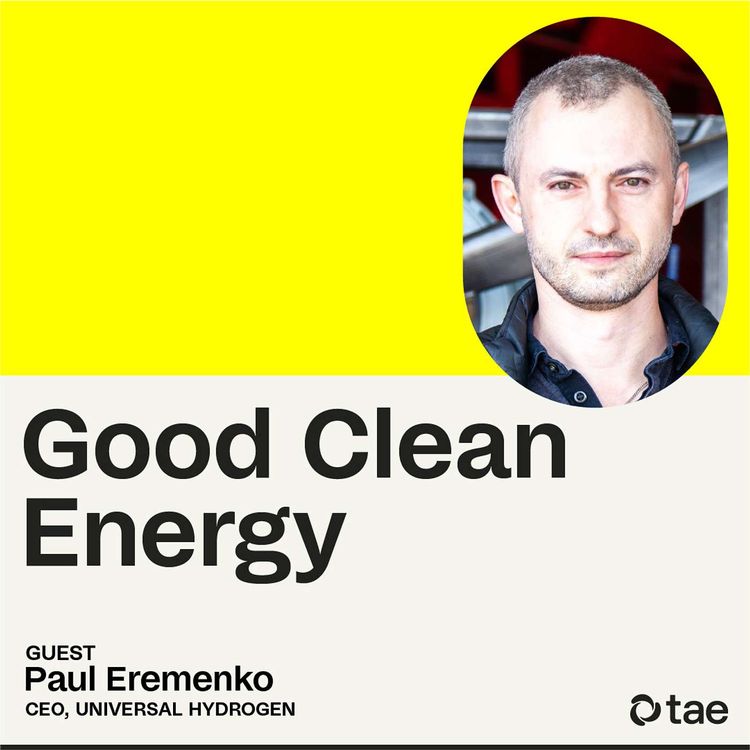
Good Clean Energy
The future of hydrogen-powered air travel, with Universal Hydrogen's Paul Eremenko
Paul Eremenko, co-founder and CEO of Universal Hydrogen, believes that there is a relatively simple way to solve the aviation industry’s carbon emissions problem. Today’s sustainable fuels aren’t really all that sustainable, he says, and electric planes, while great in theory, don’t scale. That leaves one obvious choice for Eremenko: green hydrogen. “There is a very significant sort of low-hanging fruit opportunity with no significant tech risk to put hydrogen in service and solve in one fell swoop half of aviation emissions problems by 2035,” Eremenko says.
Covered in this episode:
- [3:52] The aviation industry’s current carbon footprint
- [5:40] Why sustainable fuels aren’t really all that sustainable
- [7:12] Why electric planes aren’t feasible
- [8:27] Explaining the color spectrum of hydrogen
- [9:22] How hydrogen is safer than jet fuel
- [12:40] Technology for hydrogen fueled aviation
- [17:45] Why you can’t just fill up the existing fuel tanks with hydrogen
- [19:02] The “Nespresso pod of hydrogen”
- [21:23] Universal Hydrogen’s inaugural flight
- [23:20] How the range of a hydrogen craft compares to a regular jet-fuel plane
- [23:50] Major challenge is availability of green hydrogen
- [26:39] The economic competitiveness of hydrogen
- [27:31] A new commercial aircraft configuration
- [34:39] A few ways the aviation industry could look by 2045
For show notes and a full transcript, head to the episode page.
Listen and Follow 'Good Clean Energy' on Apple Podcasts
Listen and Follow 'Good Clean Energy' on Spotify
More episodes
View all episodes
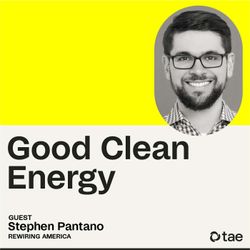
Why we need to electrify everything in our homes, with Rewiring America’s Stephen Pantano
33:55|Roughly 42% of energy-related carbon emissions come from households—our cars, water heaters, furnaces, dryers, cooktops and where we get our energy. Stephen Pantano, head of Market Transformation for Rewiring America, joins Good Clean Energy to explain how replacing fossil-fueled machines at home with electric ones is a critical and achievable strategy for reaching net zero emissions in the U.S. Covered in this episode:[2:30] The mission of Rewiring America[4:02] “The perfect household is all-electric”[5:19] Using heat pumps to heat and cool your home[9:57] Cooking without gas[12:45] Heating your water with a heat pump [14:42] Drying your clothes with a heat pump[15:32] The economic incentives to electrify your home[20:49] Where Rewiring America comes in[23:22] The challenges of rolling out the rebate programs[24:51] The roadblocks to electrifying America[26:03] The 1 billion devices that need to be upgraded[29:59] Where an individual can make the most impact[31:22] A vision for 2035For show notes and a full transcript, head to the episode page.Listen and Follow 'Good Clean Energy' on Apple Podcasts Listen and Follow 'Good Clean Energy' on Spotify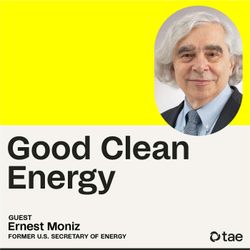
22. U.S. Climate Envoy John Kerry unveils an international fusion plan at COP28
16:06||Season 1, Ep. 22At COP28, U.S. Climate Envoy John Kerry announced a major fusion strategy for the world. Former U.S. Secretary of Energy Ernest Moniz joins Good Clean Energy from Dubai to break down this White House plan to bring fusion to market as fast as possible. For a full transcript, head to the episode page.Listen and Follow 'Good Clean Energy' on Apple Podcasts Listen and Follow 'Good Clean Energy' on Spotify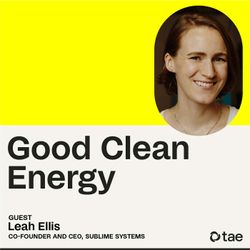
21. How to tackle cement's massive CO2 problem, with Sublime Systems' Leah Ellis
31:55||Season 1, Ep. 21Cement accounts for 8 percent of global CO2 emissions. The production of one ton of Portland cement — the kind most commonly used — results in one ton of CO2 released into the atmosphere. And since cement is exceptionally cheap and the most massively produced man-made material in the world, those emissions are going to grow. “In a do-nothing scenario, emissions from cement are projected to increase 50 percent between now and 2050,” says Dr. Leah Ellis, co-founder and CEO of Sublime Systems.Ellis’ company is producing low-carbon cement by replacing the traditional high-temperature, fossil fuel, combustion-driven kiln with an electrochemical approach that operates at ambient temperature and uses renewable electricity.“I like to say Sublime is the electric vehicle of cement making.”Covered in this episode:[3:18] How Ellis’ background in chemistry led to making carbon-free cement[5:51] Why defining cement by its performance is important[7:48] The basics of cement[9:29] The outrageous amount of cement produced annually[11:29] How Sublime Systems produces cement with fewer carbon emissions[18:06] The ability to compete economically[23:04] Scaling up Sublime’s operations[26:37 The leaky tap analogy to understand the climate crisis[29:53] A vision for the cement industry in 2035For show notes and a full transcript, head to the episode page.Listen and Follow 'Good Clean Energy' on Apple Podcasts Listen and Follow 'Good Clean Energy' on Spotify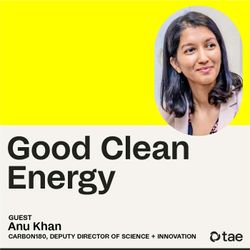
On a mission to eliminate legacy carbon emissions, with Carbon180’s Anu Khan
37:30|Anu Khan, Deputy Director of Science and Innovation at the nonprofit Carbon180, joins Good Clean Energy to discuss the ins and outs of removing carbon dioxide from the atmosphere.Throughout the industrial era, we’ve emitted roughly 2 trillion tons of carbon dioxide, 1 trillion of which is still in the atmosphere today and is going to continue to cause warming for an extended period of time. Most of that warming is caused by the burning of fossil fuels for energy, and reducing emissions is crucial to keeping global warming below the goal of 2°C. But the challenge doesn’t end there. That’s where carbon dioxide removal comes in. While there are a few ways to actually remove the carbon dioxide and there’s the question of who should really pay for it, it’s clear that CO2 removal is necessary. “It's fundamentally a climate justice solution, and carbon removed anywhere benefits everyone globally,” Khan said. Covered in this episode:[3:28] The role of carbon in our planet[5:42] Why we need carbon removal in addition to clean energy[7:38] The difference between carbon capture and carbon removal[11:28] How much CO2 we need to remove from the atmosphere[15:11] The suite of carbon removal solutions[16:38] Who pays for carbon dioxide removal[21:04] The personal carbon offset market[22:27] The potential for cost-effective CO2 removal[25:05] The leading approach to direct air capture[28:57] The most compelling argument for CO2 removal[32:19] A vision for 2035For show notes and a full transcript, head to the episode page.Listen and Follow 'Good Clean Energy' on Apple Podcasts Listen and Follow 'Good Clean Energy' on Spotify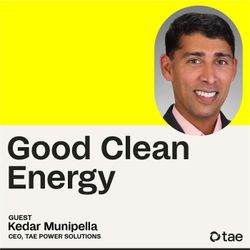
Solving today’s biggest challenges facing EVs, with TAE Power Solutions CEO Kedar Munipella
33:35|What are the biggest challenges to widespread adoption of electric vehicles? Cost, range anxiety and charge time. Kedar Munipella, CEO of TAE Power Solutions, joins the show to talk about how his company solves for all that. Working with a radical new approach to power distribution, battery performance is optimized and charge time is reduced. That, in turn, will make EVs less expensive.For show notes and a full transcript, head to the episode page.Listen and Follow 'Good Clean Energy' on Apple Podcasts Listen and Follow 'Good Clean Energy' on Spotify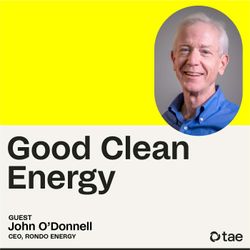
How to decarbonize manufacturing using really hot bricks, with Rondo Energy's John O'Donnell
38:33|Industrial heat accounts for 25% of global energy consumption to make products ranging from steel to cement to paper and so many other things you've probably never thought about. It’s a huge chunk of our climate problem — and it’s uniquely hard to decarbonize. That’s where John O’Donnell’s company, Rondo Energy, steps in. Rondo is using hot bricks to store energy as heat. And since industrial processes need energy in the form of heat anyway, it’s a no-brainer. “It happens to be the world’s most efficient way of storing energy,” O’Donnell said of his technology. For show notes and a full transcript, head to the episode page. Listen and Follow 'Good Clean Energy' on Apple Podcasts Listen and Follow 'Good Clean Energy' on Spotify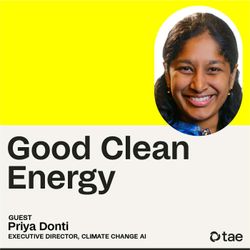
17. How AI can make the U.S. power grid supersmart, with Climate Change AI's Priya Donti
41:02||Season 1, Ep. 17Priya Donti, co-founder and executive director of Climate Change AI, joins Good Clean Energy to talk about the role AI and machine learning can play in transforming America's power grid to optimize clean power production and consumption.For show notes and a full transcript, head to the episode page.Listen and Follow 'Good Clean Energy' on Apple Podcasts Listen and Follow 'Good Clean Energy' on Spotify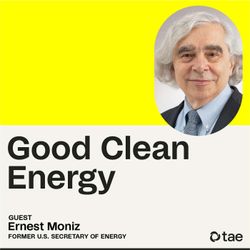
16. Ernie Moniz on “Oppenheimer” and the dawn of the nuclear age
23:56||Season 1, Ep. 16Dr. Ernie Moniz, an acclaimed nuclear physicist and former U.S. Secretary of Energy, joins Good Clean Energy again to discuss the film “Oppenheimer” and the dawn of the nuclear age through the lens of today.For show notes and a full transcript, head to the episode page.Listen and Follow 'Good Clean Energy' on Apple Podcasts Listen and Follow 'Good Clean Energy' on Spotify
15. How reshoring American manufacturing will inspire climate tech innovation, with Harvard Business School's Willy Shih
32:43||Season 1, Ep. 15Willy Shih, Professor of Management Practice in Business Administration at Harvard Business School, joins Good Clean Energy to talk about the impact of the Inflation Reduction Act on reshoring manufacturing and how it can help the U.S. reassert itself as a leader in innovation, particularly in the transition to clean energy.For show notes and a full transcript, head to the episode page.Listen and Follow 'Good Clean Energy' on Apple Podcasts Listen and Follow 'Good Clean Energy' on Spotify